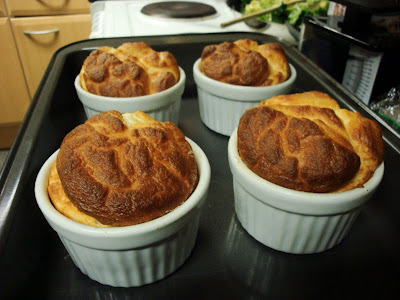
Recipe coming soon...






 For those bibliophiles out there, Hamlyn has printed a new handsome UK edition of Larousse Gastronomique. Beautiful copper-coloured hardback with a slipcover. Well done.
For those bibliophiles out there, Hamlyn has printed a new handsome UK edition of Larousse Gastronomique. Beautiful copper-coloured hardback with a slipcover. Well done. PBS had done the world a great service. Without further ado, Julia and the cheese soufflé.
PBS had done the world a great service. Without further ado, Julia and the cheese soufflé.






 n offer were some Luminarc tumblers that we fell in love with in Corsica and Italy. There's no fancy stemware; just hardy, low volume glasses.
n offer were some Luminarc tumblers that we fell in love with in Corsica and Italy. There's no fancy stemware; just hardy, low volume glasses.

Espagnole Sauce: A brown sauce, which is used as a basis for a large number of derivative brown sauces, such as Robert, genevoise, bordelaise, Bercy, Madeira, and Périgueux. It is made with a brown stock to which a brown roux and a mirepoix are added, followed by a tomato purée. Cooking takes several hours and the sauce needs to be skimmed, stirred, and strained.





Hollandaise. A hot emulsified sauce based on egg yolks and clarified butter. It is the foundation of several other sauces, including chantilly (or mousseline), maltaise, mikado and mustard sauce, depending on the ingredients added. It is served with fish cooked in a court-bouillon, or with boiled or steamed vegetables. The sauce should be made in a well-tinned copper or stainless steel sauté pan; an aluminium pan wil turn it greenish. As it must not get too hot, hollandaise sauce should be kept warm in a bain marie. If it does curdle, it can be re-emulsified by adding a spoonful of water, drop by drop; use hot water if the sauce is cold, cold water if the sauce is hot.





Ravigote. A spicy sauce served hot or cold but always highly seasoned. Cold ravigote is a vinaigrette mixed with capers, chopped herbs, and chopped onion. The hot sauce is made by adding velouté sauce to equal quantities of white wine and wine vinegar, reducing with chopped shallots; it is finished with chopped herbs and served particularly with calf's head and brains and boiled fowl.Essentially, the cold version is a herbed vinaigrette that lends itself to mussels, veggies,, and salad in general.



 Sweet and tangy and marinated, you can use the tomatoes in one dish and the olive oil in another. Just thinking about it makes my mouth water. Of course, you can use regular marinated, sun-dried tomatoes and make a darn good salad, but don't even try to call it TBPSE. I won't let you.
Sweet and tangy and marinated, you can use the tomatoes in one dish and the olive oil in another. Just thinking about it makes my mouth water. Of course, you can use regular marinated, sun-dried tomatoes and make a darn good salad, but don't even try to call it TBPSE. I won't let you.






 After spooning out our mixture into our four small ramekins, we still had plenty of batter leftover, so we put the extra into a small Pyrex bowl; in most respects it was even better. The slightly larger diameter allows the soufflé to remain fluffier. This being our first attempt at a soufflé, it was also easier to judge how well cooked it was because we could see through the glass to the base.
After spooning out our mixture into our four small ramekins, we still had plenty of batter leftover, so we put the extra into a small Pyrex bowl; in most respects it was even better. The slightly larger diameter allows the soufflé to remain fluffier. This being our first attempt at a soufflé, it was also easier to judge how well cooked it was because we could see through the glass to the base. More than halfway through the summer, we're finally tackling the first on our list of the canonical French Sauces, and one of the most straightforward ones, too. Named after the Marquis de Béchameil (1630-1703), the chief steward of Louis XIV, it was originally a velouté with heavy cream, and, in addition to nutmeg, also included bay leaf and onion as flavoring. Now, however, it commonly refers to a white sauce with simple seasoning. We were looking for a challenge, though, and our bechamel became the base of a Gruyere cheese soufflé...
More than halfway through the summer, we're finally tackling the first on our list of the canonical French Sauces, and one of the most straightforward ones, too. Named after the Marquis de Béchameil (1630-1703), the chief steward of Louis XIV, it was originally a velouté with heavy cream, and, in addition to nutmeg, also included bay leaf and onion as flavoring. Now, however, it commonly refers to a white sauce with simple seasoning. We were looking for a challenge, though, and our bechamel became the base of a Gruyere cheese soufflé...


